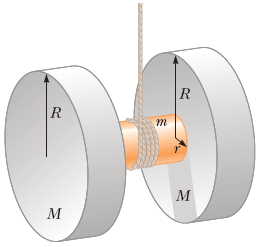An oversized yo-yo is made from two identical solid disks each of mass M = 2.30 kg and radius R = 10.5 cm. The two disks are joined by a solid cylinder of radius r = 4.00 cm and mass m = 1.00 kg as in the figure below. Take the center of the cylinder as the axis of the system, with positive torques directed to the left along this axis. All torques and angular variables are to be calculated around this axis. Light string is wrapped around the cylinder, and the system is then allowed to drop from rest. A string drops from the top of the image and winds around the inner cylindrical core—which has radius r and mass m—of a yo-yo. The outer cylinders of the yo-yo, coaxial with the inner core, each have radius R and mass M. (a) What is the moment of inertia of the system? Give a symbolic answer. (Use any variable or symbol stated above as necessary. Do not substitute numerical values; use variables only.) I = (b) What torque does gravity exert on the system with respect to the given axis? N · m (c) Take downward as the negative coordinate direction. As depicted in the figure above, is the torque exerted by the tension positive or negative? positivenegative Is the angular acceleration positive or negative? positivenegative What about the translational acceleration? positivenegative
Angular Momentum
The momentum of an object is given by multiplying its mass and velocity. Momentum is a property of any object that moves with mass. The only difference between angular momentum and linear momentum is that angular momentum deals with moving or spinning objects. A moving particle's linear momentum can be thought of as a measure of its linear motion. The force is proportional to the rate of change of linear momentum. Angular momentum is always directly proportional to mass. In rotational motion, the concept of angular momentum is often used. Since it is a conserved quantity—the total angular momentum of a closed system remains constant—it is a significant quantity in physics. To understand the concept of angular momentum first we need to understand a rigid body and its movement, a position vector that is used to specify the position of particles in space. A rigid body possesses motion it may be linear or rotational. Rotational motion plays important role in angular momentum.
Moment of a Force
The idea of moments is an important concept in physics. It arises from the fact that distance often plays an important part in the interaction of, or in determining the impact of forces on bodies. Moments are often described by their order [first, second, or higher order] based on the power to which the distance has to be raised to understand the phenomenon. Of particular note are the second-order moment of mass (Moment of Inertia) and moments of force.
An oversized yo-yo is made from two identical solid disks each of mass
and radius
The two disks are joined by a solid cylinder of radius
and mass
as in the figure below. Take the center of the cylinder as the axis of the system, with positive torques directed to the left along this axis. All torques and angular variables are to be calculated around this axis. Light string is wrapped around the cylinder, and the system is then allowed to drop from rest.
I =
(b) What torque does gravity exert on the system with respect to the given axis?
N · m
(c) Take downward as the negative coordinate direction. As depicted in the figure above, is the torque exerted by the tension positive or negative?
Is the
What about the translational acceleration?
(d) Write an equation for the angular acceleration ? (alpha) in terms of the translational acceleration a and radius r. (Watch the sign!)
| ? | = |
|
(e) Write Newton's second law for the system in terms of m, M, a, T, and g. (Submit a file with a maximum size of 1 MB.)
This answer has not been graded yet.
(f) Write Newton's second law for rotation in terms of I, ?, T, and r. (Submit a file with a maximum size of 1 MB.)
This answer has not been graded yet.
(g) Eliminate ? from the rotational second law with the expression found in part (d) and find a symbolic expression for the acceleration a in terms of m, M, g, r and R.
| a | = |
|
(h) What is the numeric value for the system's acceleration?
m/s2
(i) What is the tension in the string?
N
(j) How long does it take the system to drop 1.04 m from rest?

Trending now
This is a popular solution!
Step by step
Solved in 2 steps








